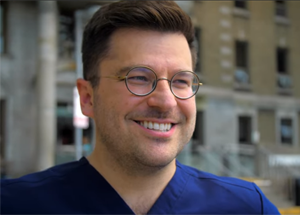 Illustrative case: Mrs. Jones is worried about her youngest daughter Emma. For the past 2 days, she had fever and productive cough and woke up this morning with difficulty breathing. Mrs. Jones called her family physician’s office but can’t get an appointment because his schedule is already overfilled. She doesn’t want to wait for her family doctor’s walk-in clinic next week, she wants her daughter to be seen by a doctor today. She decides to bring Emma to the emergency room.
Illustrative case: Mrs. Jones is worried about her youngest daughter Emma. For the past 2 days, she had fever and productive cough and woke up this morning with difficulty breathing. Mrs. Jones called her family physician’s office but can’t get an appointment because his schedule is already overfilled. She doesn’t want to wait for her family doctor’s walk-in clinic next week, she wants her daughter to be seen by a doctor today. She decides to bring Emma to the emergency room.
The traditional patient booking model
The principle of the traditional model is to address urgent cases now and see non-urgent cases later. But contrary to our first impression, it is not an efficient system. The majority of family physicians have fully booked appointment books, with follow-up visits and annual exams, for the months ahead. Receptionists often have to refuse appointments to patients because the schedules are already full. They often have to perform a triage task over the phone, trying to evaluate the patient’s problems and assess the urgency of the cases, without the appropriate knowledge base to do so. Cases that are thought to be urgent are squeezed in at lunch hours or at the end of the day.
Some family physicians have a limited amount of free appointments available given to the first patients that call the clinic on the 1st day of every month. What happens on that long-awaited morning? As a patient, you call the clinic to get an appointment, but the line is busy…because a lot of people are calling for the same reason. You call, and call, and call again and when the receptionist finally answers, she often announces that there are no more spots available and encourages you to call back next month.
Important aspects of primary care include accessibility and continuity of care. However, for the majority of patients in Quebec, timely access to their family physician is extremely difficult and consequently, patients often feel the need to go to the emergency or walk-in clinics for their primary care because the waiting time to see their family doctor is too long. This behaviour overcrowds the emergency departments with level 4 and level 5 cases that should be managed by the patient’s own family physician. The patients that go to walk-in clinics receive care from physicians that don’t know them well, which disrupts continuity of care. By the time patients get to their annual exam with their primary care physician, they often had time to recover from their illness.
In summary, patients are dissatisfied because they can’t have access to their family doctor when they need it the most (acute illness, acute exacerbations of chronic conditions, etc).
Receptionists are displeased with their work because they often have to perform triage tasks without the necessary formation to do so and they are often victim of verbal violence from angry and frustrated patients. Physicians are overwhelmed by their waiting list and frustrated to be unable to offer appropriate access to their patients when they get sick.
The Advanced Access leitmotif is that today’s work is done TODAY. Family physicians who modify their practice and adjust their schedules to practice advanced access can now offer their patients an appointment often on the same day.
What is advanced access?
Advanced access (Accès adapté, en français) is a patient booking model that was developed by Dr. Mark Murray, a family physician practicing in the United States, in an effort to improve accessibility to primary care by reducing waiting times. The principle behind Advanced Access is that patients calling to see their family physician are offered an appointment on the same day. Instead of a fully booked schedule filled with annual exams and follow-ups, you can learn to adjust your schedule and with time, leadership, commitment and teamwork, change your practice to reserve 1/3 of your schedule for the follow-ups of patient’s with chronic illnesses and to liberate the other 2/3 of your schedule to have free time to see your patients when they get sick. And as a family doctor, caring for patients in a comprehensive manner using an holistic approach, you do not only address the 1 urgent problem for which your patients present that day, as an ER physician would, NO: you take the ADVANTAGE of your patient visit to also perform elements of the annual exam (full physical exam, health promotion, prevention and screening). If we go back to our illustrative case, the family physician seeing Emma might diagnose a community acquired pneumonia, but in addition to addressing the acute issue, he should also evaluate how she is doing otherwise (taking a HEADS history: how is everything going at home, how is she performing at school, is she exercising, how are her friends relationships, etc) and perform a full physical exam including growth measurements and Tanner stage to verify that she is growing and developing as expected. At the end of the visit, instead of scheduling right away an annual exam in 1 year for Emma, Mrs. Jones is told to call back in one year for her child’s annual visit or to call back as needed if Emma gets sick again.
The Advanced Access leitmotif is that today’s work is done TODAY. Family physicians who modify their practice and adjust their schedules to practice advanced access can now offer their patients an appointment often on the same day. The waiting time is markedly decreased, and patients are able to see their primary care physician within 1 day to 2 weeks, depending on their preference and condition. The system is build to respond to the needs of patients and offer them an appointment when they need it.
The system has been implemented in the United States, and has been introduced in many Canadian provinces, including British Columbia, Alberta, Manitoba, Ontario and Nova Scotia. It was first introduced in Quebec in May 2012. Studies on Advanced Access are showing that this model:
- improves accessibility by reducing waiting time
- increases office efficiency and patient flow, thereby increasing physician’s salary
- improves continuity of care because patients are seen by their family doctor instead of an emergency physician or another family physician in a walk-in clinic
- improves patient’s satisfaction and quality of care because patients are seen early in the course of their illness and cared for by the physician who knows them
- improves physician’s satisfaction, restore a sense of ‘’control’’ physicians have on their schedule, improves their quality of life and spice up their practice because of the increased number of acute problems to manage
- improves clerical staff satisfaction and quality of life as they no longer have arguments with patients about appointments and no longer have to triage patients
- reduces no-show appointments
- reduces non-urgent visits to the ED
How to adopt the Advanced Access model?
How can a family doctor make the transition from the traditional patient booking model to Advanced Access? It is a long process (can take months, even 1-2 years, depending on the physician’s practice) that requires leadership and commitment, but it can be done by applying the following elements.
1. Demand vs Supply: In order to implement Advanced Access, physicians must have a solid understanding of their demand (the size of their patient pool and the type of patients they treat, calculating that the vulnerable populations have a higher demand for visits) and their supply (the number of appointments spots available). Similar to the way economists calculate demand and supply, physicians must calculate their demand and their supply and balance the two. Advanced Access can’t work in the longterm if a physician’s demand is higher than his supply. If this is the case, and the physician is determined to adopt Advanced Access, he must make modifications to his practice and renounce to some other clinical activities in order to spend more time in clinic to increase his supply in order to meet demand. That’s how you restore the balance.
2. Reducing backlog: Before achieving Advanced Access, physicians must take care of all the future appointments they have over the next few months, in order to liberate 2/3 of their schedule. To do so, they can either do more work each day for a specific period of time (longer hours, add working days) or deal with some appointments in other ways (such as telephone calls or e-mails). For example, a physician that sees 40 patients a day will be able to reduce 1 month of backlog by temporarily seeing an extra 20 patients per day for a period of 2 months by working longer hours.
3. Expect the unexpected and plan accordingly: Before reaching Advanced Access, physicians must know the periods of the year when demand increases (example: influenza season) or supply decreases (example: physicians vacations during Christmas or summer). To avoid those changes to affect the work that has to be done today, physicians can temporarily increase their work hours to meet demand during those busy periods.
4. Reduce demand and shape visits: It is important for efficiency that each physician takes care of his patient population as there is a decrease in demand when patients can see their own family physician. Furthermore, to improve efficiency, physicians should continue to offer comprehensive care to their patients. Advanced Access should not become a walk-in clinic. Physicians practicing Advanced Access should only be accessible to THEIR patients and are able to address and cover multiple issues during a single visit, including parts of the annual exam in order to avoid another appointment in a few months.
5. Teamwork: Advanced Access cannot work if physicians do not adopt a multidisciplinary approach and work as a team. Physicians must learn how to delegate and give higher levels of responsibility to nurses, and medical assistants, and to use the resources that their colleagues (nurse practitioners, nutritionists, physiotherapists, occupational therapists, social workers, psychologists, etc) have to offer.
Since May 2012, more and more family physicians are deciding to practice Advanced Access in Quebec. It is an example of innovation and quality improvement that is increasing accessibility to primary care and having tangible benefits on the health care system. I hope you enjoyed learning about this new way to practice family medicine!
 Natacha Kardous
Natacha Kardous
McGill University
References:
- Advanced Access: Reducing Waiting and Delays in Primary Care. Mark Murray, Donald M. Berwick. JAMA, Vol. 289, No. 8, page 1035-1040, Febuary 2003.
- Advanced access appointments: effects on family physician satisfaction, physician’s office income and emergency department use. J.C. Hudec, S. MacDougall, E. Rankin. Canadian Family Physician, Vol. 56, page 361-367, October 2010.
Interesting Video (in French)
Accès adapté en Montérégie, CSSS Vaudreuil-Soulages, Dre Manon Proulx :










